Egyptian - Vessels - Egypt and North Africa - Sold antiquities
Archive of sold antiquities
All artefacts sold in our gallery are fully documented in our online archive and database. Being a specialist ancient art dealer, preserving also the more recent history of each and every piece sold in our shop is at our heart. That is particularly useful for artefacts that changed owners in the meantime. Information that may have been lost in the process can be easily restored from our archives. Please do not hesitate to contact us if you need further information about ancient items that have been sold in our gallery. We can help you with reconstructing the history of ownership for those items. All information about our customers will be kept confidential, of course.-
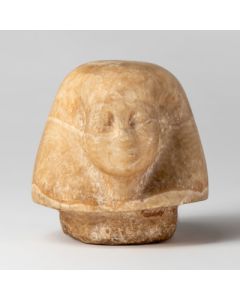 Canopic jar lid of the 18th dynasty from museum collection
Canopic jar lid of the 18th dynasty from museum collectionEgyptian canopic jar lid in the shape of a human head, dating to the New Kingdom of ancient Egypt. The high quality alabaster piece came to the Cincinnati Art Museum in 1888 and was part of the museum collection for more than 100 years.
Price: on request Egyptian model vessels of a founding ceremony
Egyptian model vessels of a founding ceremonyA group of seven miniature bowls and three miniature vases made of clay. Once filled with offerings and used ritually during a foundation stone laying ceremony. Dating to the Old Kingdom, around 2500 BC.
Price: on request Egyptian stone beaker
Egyptian stone beakerThe elegant stone vase was probably used as an ointment vessel. 5th to 6th dynasty of ancient Egypt, Old Kingdom.
Price: on request Egyptian chalice
Egyptian chaliceThe thin-walled stone cup is reminiscent of a lotus bud. From the collection of Egyptologist Professor Wiedemann. 18th dynasty of Ancient Egypt.
Price: on request Slender Egyptian stone beaker
Slender Egyptian stone beakerThe small and tall stone vessel is made of alabaster. From the collection of Egyptologist Professor Wiedemann.
Price: on request Egyptian stone vessel from Luxor
Egyptian stone vessel from LuxorThe cosmetic vessel is of a rare type. From the collection of Egyptologist Professor Wiedemann. Middle Kingdom of Ancient Egypt
Price: on request Egyptian green stone vessel
Egyptian green stone vesselThe stone vessel is made of beautiful green serpentine. From the collection of Egyptologist Professor Wiedemann. Middle Kingdom of Ancient Egypt.
Price: on request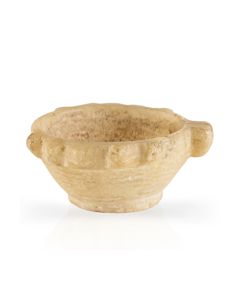 Egyptian alabaster bowl from Luxor
Egyptian alabaster bowl from LuxorThe small stone vessel is an offering bowl for libation. From the collection of Egyptologist Professor Wiedemann. 12th to 18th dynasty of Ancient Egypt
Price: on request Egyptian stone bowl
Egyptian stone bowlThis wonderful and relatively large bowl of banded stone was probably used for ritual purposes. From the Early Dynastic Period or Old Kingdom of ancient Egypt.
Price: on request Egyptian alabaster vessel
Egyptian alabaster vesselLarge container for this type of vessel. A thin-walled and very skilfully crafted specimen. Made between the 12th and 18th dynasty of Ancient Egypt.
Price: on request Canopic jar of Imsety
Canopic jar of ImsetyEgyptian Late Period canopic jar with a lid in the shape of a human head, representing the Horus son Imsety. The piece stands out by the expressive face and by the original painting.
Price: on request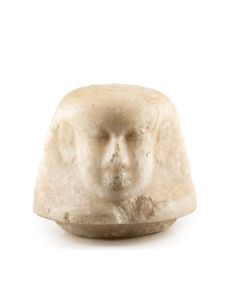 Large canopic jar lid with Imsety
Large canopic jar lid with ImsetyEgyptian Late Period canopic jar lid in the shape of a human head. The piece is impressive due to its massive size and high-quality craftsmanship.
Price: on request Predynastic vase decorated with spirals
Predynastic vase decorated with spiralsPainted vessel of the Naqada II culture. Perfect example of the early art of prehistoric Egypt.
Price: on request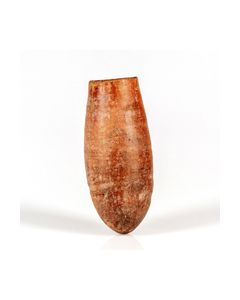 Egyptian predynastic redware jar
Egyptian predynastic redware jarSimple pottery vessel of timeless elegance. From the Naqada I period, 4th Millenium BC.
Price: on request Egyptian Kohl vessel
Egyptian Kohl vesselThe small stone pot of nicely polished granite was used for Kohl, the eye cosmetic of the ancient Egyptians. From the time between Middle Kingdom and New Kingdom.
Price: on request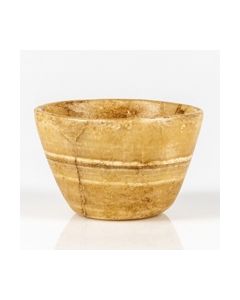 Egyptian stone bowl
Egyptian stone bowlThis wonderful bowl of banded stone was probably used for ritual purposes. From the Early Dynastic Period or Old Kingdom of ancient Egypt.
Price: on request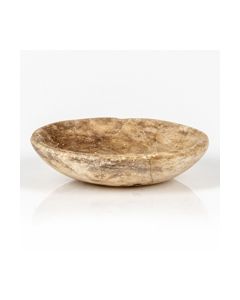 Shallow bowl from Egypt
Shallow bowl from EgyptMade of nicely banded Egyptian alabaster. High quality bowl with a fine polish. Early Dynastic to Old Kingdom.
Price: on request Small Egyptian Kohl vessel
Small Egyptian Kohl vesselThe stone pot was used for Kohl, the eye cosmetic of the ancient Egyptians. Vessel with well preserved body and missing rim. From the 2nd Millenium BC.
Price: on request Small Egyptian Kohl vessel
Small Egyptian Kohl vesselThe stone pot was used for Kohl, the eye cosmetic of the ancient Egyptians. Vessel with well preserved body and missing rim. From the 2nd Millenium BC.
Price: on request Small Egyptian stone vessel
Small Egyptian stone vesselNice stone vessel and rare type from the Middle Kingdom. Timelessly elegant shape.
Price: on request Perfectly preserved ampulla of Saint Menas
Perfectly preserved ampulla of Saint MenasAmpulla of Saint Menas, a late-third-century Egyptian Roman soldier who was martyred for his Christian faith. From the collection of Prof. Dilling, acquired in the early 1900s.
Price: on request Early Christian pilgrim flask with St. Menas
Early Christian pilgrim flask with St. MenasAmpulla of Saint Menas, a late-third-century Egyptian Roman soldier who was martyred for his Christian faith. From the collection of Prof. Dilling, acquired in the early 1900s.
Price: on request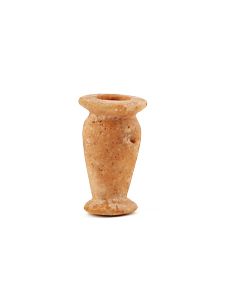 Alabaster vessel
Alabaster vesselSlender container made of beige stone. From the Eastern Mediterranean.
Price: on request Pre-Dynastic pottery of Ancient Egypt
Pre-Dynastic pottery of Ancient EgyptThe simple vessel is made of coarse clay. It dates to the end of the 4th millenium BC and hence witnessed the beginning of the Ancient Egyptian civilization.
Price: on request Egyptian New Year flask with ornamentation
Egyptian New Year flask with ornamentationHieroglyphic inscription expressing New Year wishes for Ptah at the beginning of the nile floodings. Important 26th dynasty piece associated with the Egyptian New Year rituals. The object is a fantastic example of the skilled workmanship and artistic quality of faience in ancient Egypt.
Price: on request Ägyptisches Tongefäß aus Abydos, Altes Reich
Ägyptisches Tongefäß aus Abydos, Altes ReichTypische Alltagskeramik mit rotem Überzug. Einsatz z.B. als Geschirr für Lebensmittel. 3. Jt. v. Chr. Aus Ausgrabung des Egyptian Exploration Fund.
Price: on request Ägyptischer Deckel einer Dose aus Abydos
Ägyptischer Deckel einer Dose aus AbydosHolzdeckel aus koptischer Zeit mit interessantem Schließmechanismus. Fund des Egyptian Exploration Fund in Abydos.
Price: on request Prädynastische ägyptische Keramikschale
Prädynastische ägyptische KeramikschaleSehr seltene, frühe Keramik aus der prädynastischen Naqada-Zeit Ägyptens. Etwa 4000 bis 3200 v. Chr.
Price: on request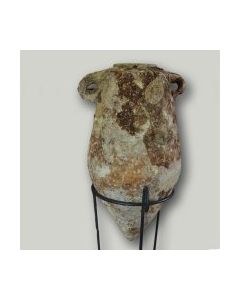 Phoenician wine amphora - found in a shipwreck at Kos island
Phoenician wine amphora - found in a shipwreck at Kos islandDating to the 7th cent. BC. Phoenician production for the wine trade in the Eastern Mediterranean and Carthage.
Price: on request Perfectly preserved ampulla of Saint Menas
Perfectly preserved ampulla of Saint MenasFrühchristliche Pilgerflasche mit Darstellung des Heiligen Menas. Aus der sehr alter US-Amerikanischer Sammlung des Pharmakologen Prof. Dilling, erworben in den frühen 1900er Jahren. Als Kauf- oder Fundort ist Alexandria überliefert.
Price: on request

